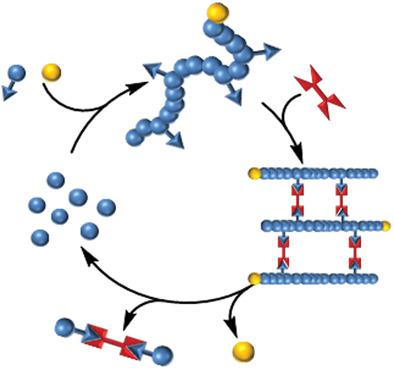当前位置:
X-MOL 学术
›
Macromol. Chem. Phys.
›
论文详情
Our official English website, www.x-mol.net, welcomes your
feedback! (Note: you will need to create a separate account there.)
Stimuli-Responsive Depolymerization of Poly(Phthalaldehyde) Copolymers and Networks
Macromolecular Chemistry and Physics ( IF 2.5 ) Pub Date : 2021-08-02 , DOI: 10.1002/macp.202100111 Shafer Soars 1 , Joshua Kamps 1 , Benjamin Fairbanks 2 , Christopher Bowman 2
Macromolecular Chemistry and Physics ( IF 2.5 ) Pub Date : 2021-08-02 , DOI: 10.1002/macp.202100111 Shafer Soars 1 , Joshua Kamps 1 , Benjamin Fairbanks 2 , Christopher Bowman 2
Affiliation

|
This article describes a stimuli-responsive cross-linked network based on a poly(phthalaldehyde) (PPA) self-immolating polymer backbone which, upon removal of polymer end-caps, becomes degradable under ambient conditions. Self-immolating polymers (SIPs) are of particular interest due to their ability to undergo controlled depolymerization resulting in the elimination of the polymer structure and potential recovery and reuse of the original monomers. Linear copolymers of phthalaldehyde and unsymmetrical allylated-phthalaldehyde monomers are obtained via anionic polymerization with appreciable incorporation of the allyl-functional monomeric units. This approach enables crosslinking of the otherwise linear polymers via thiol–ene reactions with the allyl functional phthalaldehyde polymers. The polymer network thus formed unzips along the phthalaldehyde backbone to yield monomers and low molecular weight fragments in response to chemical (F−, H+) or physical (light, sonication) stimuli that remove the stabilizing functional endcaps on the phthalaldehyde polymers. Rheology is used to demonstrate gelation within 5 s of light exposure of the allylated-phthalaldehyde polymers reacted with pentaerythritol tetrakis(3-mercaptopropionate) and photoinitiator (3 wt%). Triggerable degelation makes this material well suited for photolithography and additive manufacturing as well as other applications that necessitate polymer network degradation or elimination. Further, a method is described for determining the degelation temperature of a self-immolative cross-linked network.
中文翻译:

聚(苯甲醛)共聚物和网络的刺激响应解聚
本文描述了一种基于聚苯二醛 (PPA) 自焚聚合物主链的刺激响应交联网络,该主链在去除聚合物端帽后,在环境条件下可降解。自焚聚合物 (SIP) 尤其令人感兴趣,因为它们能够进行受控解聚,从而消除聚合物结构并可能回收和再利用原始单体。苯二醛和不对称烯丙基化苯二醛单体的线性共聚物是通过阴离子聚合获得的,其中明显掺入了烯丙基官能单体单元。这种方法可以通过硫醇 - 烯与烯丙基官能苯二醛聚合物的反应实现线性聚合物的交联。− , H + ) 或物理(光、超声)刺激,去除苯二醛聚合物上的稳定功能封端。流变学用于证明与季戊四醇四 (3-巯基丙酸酯) 和光引发剂 (3 wt%) 反应的烯丙基苯二醛聚合物在曝光 5 秒内凝胶化。可触发去凝胶使这种材料非常适合光刻和增材制造以及其他需要聚合物网络降解或消除的应用。此外,描述了一种用于确定自燃交联网络的解凝胶温度的方法。
更新日期:2021-09-07
中文翻译:

聚(苯甲醛)共聚物和网络的刺激响应解聚
本文描述了一种基于聚苯二醛 (PPA) 自焚聚合物主链的刺激响应交联网络,该主链在去除聚合物端帽后,在环境条件下可降解。自焚聚合物 (SIP) 尤其令人感兴趣,因为它们能够进行受控解聚,从而消除聚合物结构并可能回收和再利用原始单体。苯二醛和不对称烯丙基化苯二醛单体的线性共聚物是通过阴离子聚合获得的,其中明显掺入了烯丙基官能单体单元。这种方法可以通过硫醇 - 烯与烯丙基官能苯二醛聚合物的反应实现线性聚合物的交联。− , H + ) 或物理(光、超声)刺激,去除苯二醛聚合物上的稳定功能封端。流变学用于证明与季戊四醇四 (3-巯基丙酸酯) 和光引发剂 (3 wt%) 反应的烯丙基苯二醛聚合物在曝光 5 秒内凝胶化。可触发去凝胶使这种材料非常适合光刻和增材制造以及其他需要聚合物网络降解或消除的应用。此外,描述了一种用于确定自燃交联网络的解凝胶温度的方法。











































 京公网安备 11010802027423号
京公网安备 11010802027423号